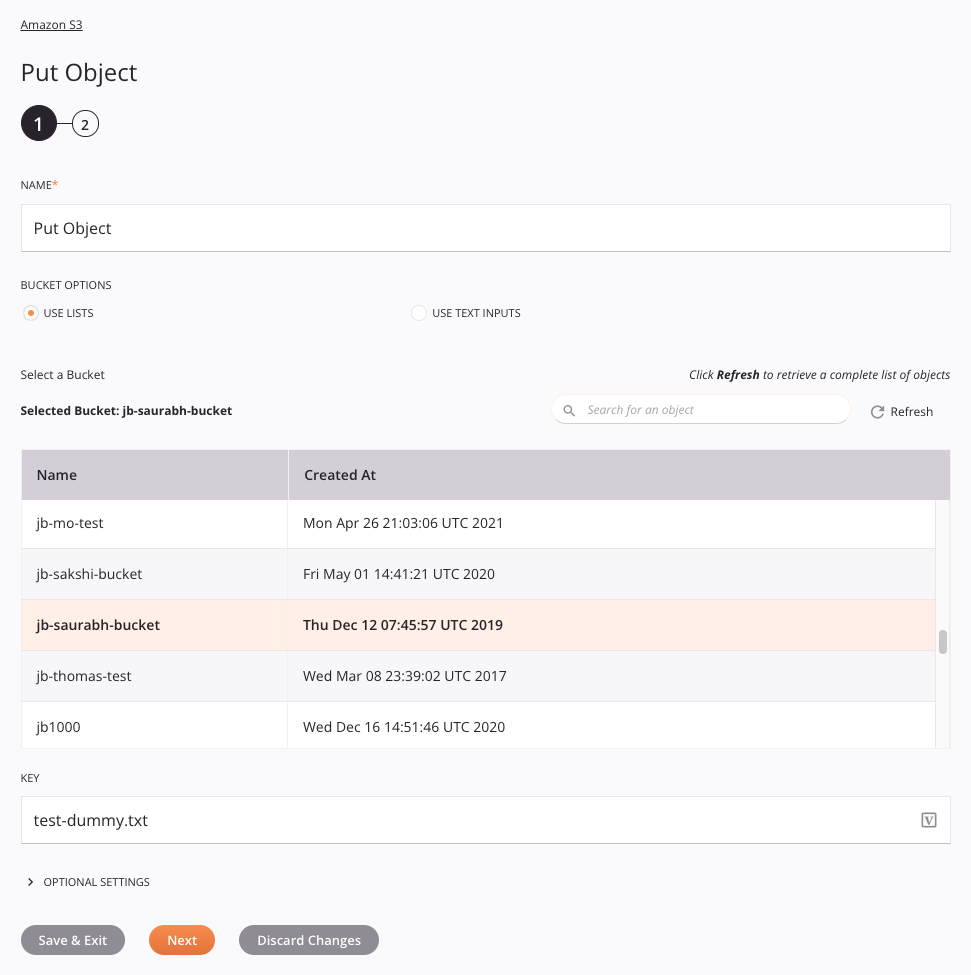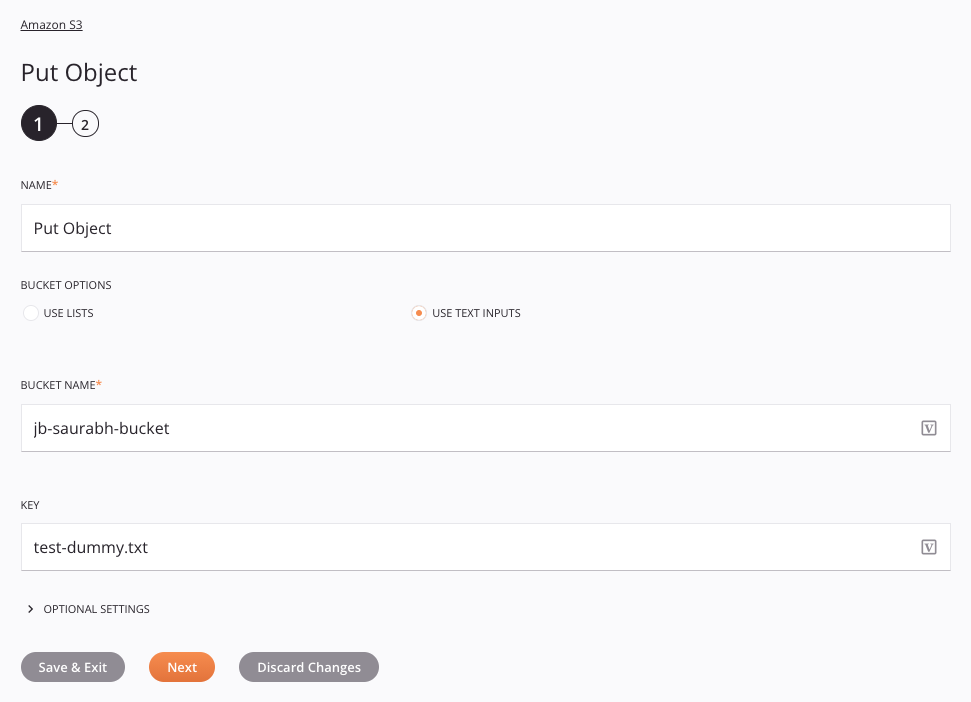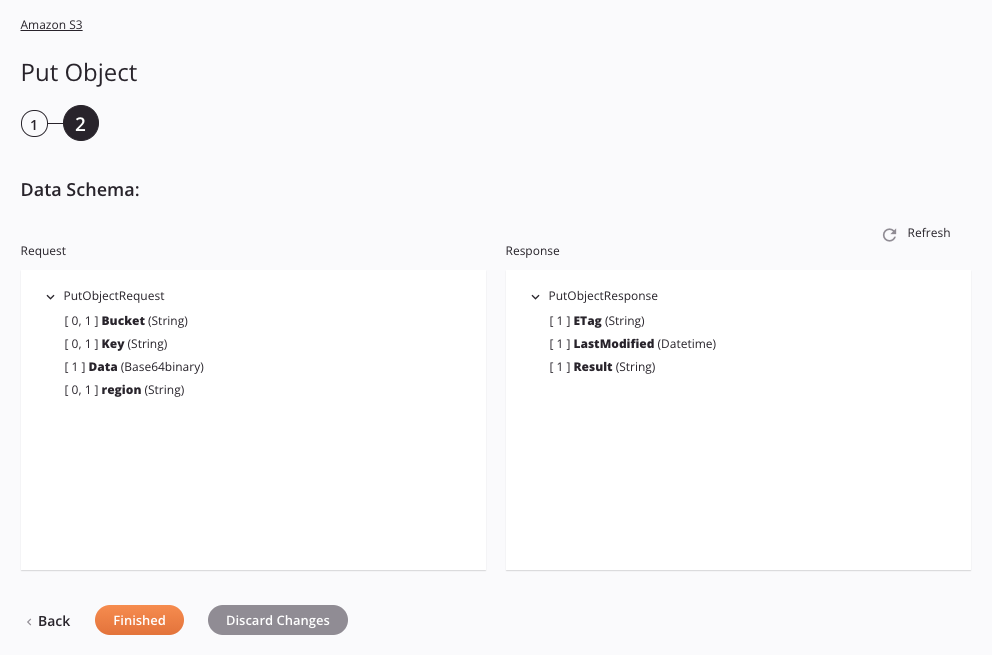Amazon S3 Put Object activity¶
Introduction¶
An Amazon S3 Put Object activity, using its Amazon S3 connection, places object data into Amazon S3 and is intended to be used as a target to consume data in an operation.
Create an Amazon S3 Put Object activity¶
An instance of an Amazon S3 Put Object activity is created from an Amazon S3 connection using its Put Object activity type.
To create an instance of an activity, drag the activity type to the design canvas or copy the activity type and paste it on the design canvas. For details, see Creating an activity instance in Component reuse.
An existing Amazon S3 Put Object activity can be edited from these locations:
- The design canvas (see Component actions menu in Design canvas).
- The project pane's Components tab (see Component actions menu in Project pane Components tab).
Configure an Amazon S3 Put Object activity¶
Follow these steps to configure an Amazon S3 Put Object activity:
-
Step 1: Enter a name and select a bucket
Provide a name for the activity and select a bucket to be used. -
Step 2: Review the data schemas
Any request or response schemas generated from the endpoint are displayed.
Step 1: Enter a name and select a bucket¶
In this step, provide a name for the activity and select a bucket to be used.
The interface used in this step of the configuration of an Amazon S3 Put Object activity depends on the Bucket Options selected:
-
Use lists: This option will populate a list of existing buckets to choose from.
-
Use text inputs: For this option, you will manually enter the name of the Amazon S3 bucket.
Use lists¶
If Use Lists is selected for Bucket Options, this interface is presented:

Tip
Fields with a variable icon ![]() support using global variables,project variables, and Jitterbit variables. Begin either by typing an open square bracket
support using global variables,project variables, and Jitterbit variables. Begin either by typing an open square bracket [ into the field or by clicking the variable icon to display a list of the existing variables to choose from.
-
Name: Enter a name to identify the activity. The name must be unique for each Amazon S3 Put Object activity and must not contain forward slashes (
/) or colons (:). -
Select a Bucket: From the populated list, select the bucket containing the object.
-
Key: Enter the key of the object that you want to retrieve from the bucket. This will be ignored if either
bucketNameorobjectIdis specified in the data schemaPutObjectRequest. -
Optional Settings: Click to expand additional optional settings:

- AWS Region (Overrides Bucket's Region): Select an Amazon S3 Region.
-
Save & Exit: If enabled, click to save the configuration for this step and close the activity configuration.
-
Next: Click to temporarily store the configuration for this step and continue to the next step. The configuration will not be saved until you click the Finished button on the last step.
-
Discard Changes: After making changes, click to close the configuration without saving changes made to any step. A message asks you to confirm that you want to discard changes.
Use text inputs¶
If Use Text Inputs is selected for Bucket Options, this interface is presented:

-
Name: Enter a name to identify the activity. The name must be unique for each Amazon S3 Put Object activity and must not contain forward slashes (
/) or colons (:). -
Bucket Name: Enter the name of the Amazon S3 containing the object.
-
Key: Enter the key of the object that you want to retrieve from the bucket. This will be ignored if either
bucketNameorobjectIdis specified in the data schemaPutObjectRequest. -
Optional Settings: Click to expand additional optional settings:

- AWS Region (Overrides Bucket's Region): Select an Amazon S3 Region.
-
Save & Exit: If enabled, click to save the configuration for this step and close the activity configuration.
-
Next: Click to temporarily store the configuration for this step and continue to the next step. The configuration will not be saved until you click the Finished button on the last step.
-
Discard Changes: After making changes, click to close the configuration without saving changes made to any step. A message asks you to confirm that you want to discard changes.
Step 2: Review the data schemas¶
Any request or response schemas generated from the endpoint are displayed. Each user interface element of this step is described below.

-
Data Schemas: These data schemas are inherited by adjacent transformations and are displayed again during transformation mapping.
Note
Data supplied in a transformation takes precedence over the activity configuration.
The Amazon S3 connector uses the AWS SDK for Java version 1.11.604. Refer to the API documentation for information on the schema nodes and fields.
The request and response data schemas consist of these nodes and fields:
Request Schema Field/Node Amazon S3 API Field/Method Description PutObjectRequest UploadPartRequest Request to place content in a bucket as a multipart upload Bucket bucketName String with the name of the bucket containing the existing, initiated multipart upload, with which this new part will be associated Key key String with the key of the initiated multipart upload Data key Base64binary containing the contents of the object, to be uploaded as a multipart upload
Tip
You can use a combination of Jitterbit's
Base64Encode,HexToBinary, andStringToHexfunctions to convert data to base64binary:$amazonData = Base64Encode(HexToBinary(StringToHex($myData)));Response Schema Field/Node Amazon S3 API Field/Method Description PutObjectResponse CompleteMultipartUploadResult Response from placing content in a bucket as a multipart upload ETag getETag The entity tag identifying the new object LastModified getLastModified Datetime value of the Last-Modified header, indicating the date and time at which Amazon S3 last recorded a modification to the associated object Result n/a String of the result -
Refresh: Click the refresh icon
 or the word Refresh to regenerate schemas from the Amazon S3 endpoint. This action also regenerates a schema in other locations throughout the project where the same schema is referenced, such as in an adjacent transformation.
or the word Refresh to regenerate schemas from the Amazon S3 endpoint. This action also regenerates a schema in other locations throughout the project where the same schema is referenced, such as in an adjacent transformation. -
Back: Click to temporarily store the configuration for this step and return to the previous step.
-
Finished: Click to save the configuration for all steps and close the activity configuration.
-
Discard Changes: After making changes, click to close the configuration without saving changes made to any step. A message asks you to confirm that you want to discard changes.
Next steps¶
After configuring an Amazon S3 Put Object activity, complete the configuration of the operation by adding and configuring other activities, transformations, or scripts as operation steps. You can also configure the operation settings, which include the ability to chain operations together that are in the same or different workflows.
Menu actions for an activity are accessible from the project pane and the design canvas. For details, see Activity actions menu in Connector basics.
Amazon S3 Put Object activities can be used as a target with these operation patterns:
- Transformation pattern
- Two-transformation pattern (as the first or second target)
To use the activity with scripting functions, write the data to a temporary location and then use that temporary location in the scripting function.
When ready, deploy and run the operation and validate behavior by checking the operation logs.